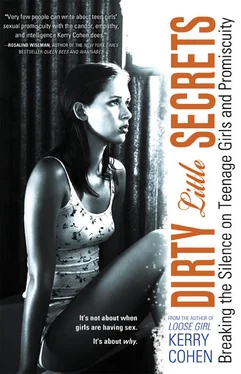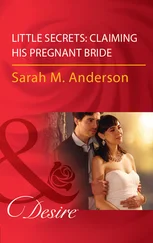Beatrice asked me outright how to say no. She felt like she needed a script—a polite set of lines she could follow each time—so she would stop having sex with men she didn’t want to have sex with simply because they wanted her to. We came up with a few responses she could feel comfortable with, including white lies about why she couldn’t: “I have to get up early tomorrow,” “I’m not feeling well,” “I have a boyfriend.” Some may judge her for the white lies. People may think Beatrice should simply say, “I don’t want to” and leave it at that. Of course she should be able to do that, but she didn’t feel ready. Saying “I don’t want to” meant they wouldn’t try again. It meant she would have to let go of the idea that their wanting her mattered in a larger way. She wasn’t at a stage in her recovery where she could do that yet.
The law defines rape as forcible sexual relations with a person against that person’s will. Seems simple enough. But nothing about sex—and particularly sex among minors—is simple. Thirty-three percent of sexually active teens aged 15–17 report that sexual activity moved too fast in their relationships. Twenty-four percent have engaged in sexual activity that they didn’t really want to do. {93} 93 6. Kaiser Family Foundation, T. Hoff, L. Greene, and J. Davis, “National Survey of Adolescence and Young Adults: Sexual Health Knowledge, Attitudes and Behaviors,” Henry J. Kaiser Family Foundation, May 2003, www.kff.org/youthhivstds/upload/National-Survey-of-Adolescents-and-Young-Adults-Sexual-Health-Knowledge-Attitudes-and-Experiences-Summary-of-Findings.pdf .
And in a study published in the Journal of Sex Research , of all the times committed couples aged 18–24 had sex, only one in five of those times did the coupling include desire. {94} 94 7. S. A. Vannier and L. F. O’Sullivan, “Sex without Desire: Characteristics of Occasions of Sexual Compliance in Young Adults’ Committed Relationships,” Journal of Sex Research 47, no. 5 (2010): 429–439.
In other words, women had consensual sex much more often than they actually desired the sex. In an essay titled “The Not-Rape Epidemic,” Latoya Peterson notes all the ways she and her friends have been “not raped” in their lives and how that has harmed them. For example, how many times do girls walk down the street and get catcalled by grown men? How many times do girls have sex because they want to be liked, or approved of, or loved? How many times do girls lie about their ages to men and then wind up having sex with them? {95} 95 8. Latoya Peterson, “The Not-Rape Epidemic,” in Yes Means Yes! Visions of Female Sexual Power and a World without Rape , ed. Jaclyn Friedman and Jessica Valenti (Berkeley, CA: Seal Press, 2008), 209–219.
As we begin to think more deeply about the complications regarding teenage sexual behavior, the language of rape clearly becomes inadequate.
I certainly experienced this ambiguity myself. I wanted to have sex, sort of. But the desire I had for sex was so completely submerged beneath my desire for attention and love that I couldn’t be sure if that were true. Every time I had sex, I had no sexual agency, no sense of my own sexual desire. Instead, my neediness controlled my sexual choices. In this way, I had no sexual self, no self that wanted to have sex for sex’s sake. If there was no clear sexual self, then how could I consent to anything? I had absolutely no connection, no consciousness or awareness about the part of me that might want in an unadulterated way to have sex.
In truth, few girls have access to that sexual self. The sexual self is buried deeply beneath all the ways we have worked culturally to keep girls from having a sexual consciousness. Lee Jacobs Riggs writes in an essay:
I let him touch me, never saying no, never saying yes, never probing too much into what his on-and-off girlfriend knew or thought about it. At the same time, I reclaimed the word “slut,” told my friends it was good, I wanted it. I excelled at giving blowjobs because I had wanted to excel at something.
Who knows what I wanted. I know that I had a need to assert myself as a sexual person to a world that had tried to erase that part of me that I felt so significantly. I know that I didn’t want him, but I did want something. {96} 96 9. Lee Jacob Riggs, “A Love Letter from an Anti-Rape Activist to Her Feminist Sex-Toy Store,” in Friedman and Valenti, Yes Means Yes! , 114.
I heard the same sentiment from many of the girls I interviewed. They too had acquaintance rape experiences—they thought. They too hadn’t necessarily wanted to have sex with most of the boys they had had sex with—they thought. The uncertainty I heard again and again is suggestive that many girls—all girls, not just loose girls—don’t have access to a part of themselves that might know what it wants regarding sex. If you don’t know what you want, how can you articulate clearly what it is?
The age-of-consent law, which is the state-by-state determined age by which point a girl is allowed to consent, was established to protect young girls, but it’s easy to see how it furthers the notion that until a girl reaches the age of consent—usually sixteen or seventeen— no consent is acknowledged. Before that age, she is the victim of statutory rape. So, for example, a girl who is fourteen may date a boy who is seventeen. Their relationship might include all the typical excitement and feelings of love and drama found in teenage relationships. But if they have sex, mutually consented to in their minds, the boy can be convicted of statutory rape, and the girl can be left with confusion about this idea that she’s been “raped.” If she understands, as most girls do, that rape means she was forced against her will, how will she reconcile her feelings about her boyfriend and this “fact”?
The law puts forth that same denial about teenage girls having sexual desire. The problem with that, of course, is that teenagers have sex. You can tell them not to all you want, but they have the same biological urge you and I do, maybe stronger, and they don’t have the developmental perspective to control their impulses as well as we do. Then add to that the girl who believes that if she says no to her boyfriend, he’ll find someone else who will have sex with him, and add to that the girl who wants a boy’s attention and knows this is how to get it.
Consent laws have a solid purpose to protect girls when they are truly victims, but legally designating an entire group of people as unable to consent to sex is maybe not the best way to protect girls from having sex that adults don’t want them to have (I should note here that an example of a girl truly being a victim, in my opinion, would be when the male counterpart is twenty or older, and the female is fifteen or younger; in such a situation there is undoubtedly a power differential at play). The Netherlands has a great example of how to use such a law to protect rather than silence. There, sexual intercourse between people aged 12–16 is legal, but victims who were coerced or forced and need the law’s protection can opt to use the statutory consent age of sixteen to prove that a violation occurred. Also, parents can overrule the wishes of a sixteen-year-old, but only if they make a convincing argument to child protective services. {97} 97 10. Levine, Harmful to Minors , 89.
An example of this might be if a fourteen-year-old girl were in a verbally abusive relationship with a seventeen–year-old boy, but she was too blinded by her feelings for the boy, or too scared, to see that. Her parents could then employ the consent age of sixteen to press charges against the boyfriend if they can prove the verbal abuse. This law views young people as capable, thinking, self-contained people who can reasonably make decisions for themselves. So, while teenage girls in the Netherlands start having intercourse much earlier, the country also sees some of the lowest teen pregnancy birth and abortion rates (approximately one in one thousand births) and STD rates in the Western world, which gives evidence of their increased levels of contraceptive use.
Читать дальше












